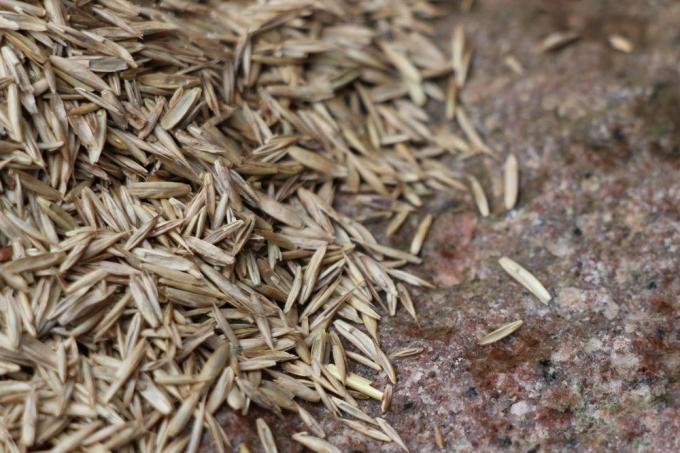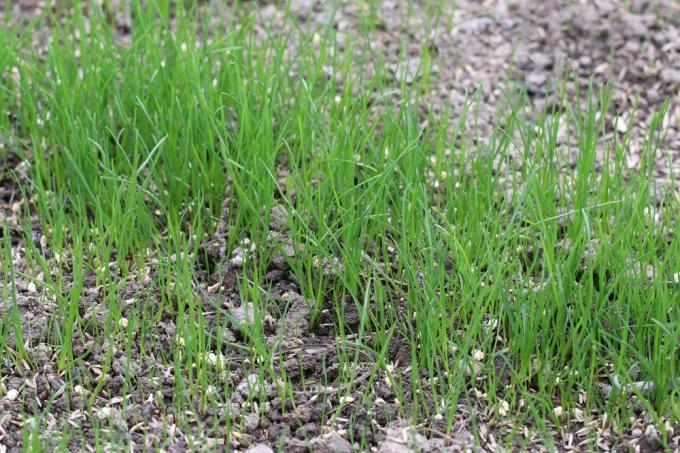
table of contents
- Germination time
- Influencing factors
- water
- oxygen
- temperature
- differences
- Optimal conditions
- Turbo seed shortens germination time
For a nice green and dense race there is a lot to do in the garden. The foundation stone for this is already laid by correct soil preparation and sowing. How long it takes from sowing to germination of the lawn depends on various factors. The most important information about the germination time of the lawn can be found here.
Of course, regular care must not be forgotten during the germination period of lawn seeds. Even mistakes when laying out a lawn can quickly shatter the dream of a green idyll.
Choosing which lawn seeds to use can easily become a challenge. A wide variety of mixtures are available on the market. Good seed germination is then also required. It is important that the so-called primary dormancy (natural dormancy) that every grass seed possesses is overcome. There are various things to consider.
Germination time
Influencing factors
The dormancy is different for the individual types of grass. For this reason, all seeds do not germinate at the same time. Of course, the germination time of lawn seeds also depends on the variety. In addition, however, various factors can also influence the length of the germination time, such as
- water
- oxygen
- temperature
water
By giving water, the seeds swell before germination. This not only increases their volume significantly, but also activates enzymes such as diastase. This enzyme is responsible for converting starch into sugar. The stored nutrients are then available to the seedling. In other words, the germination process can begin.
After sowing, regular watering is of course a prerequisite for the development of the seedlings. The germinating seeds must always be prevented from drying out, otherwise the germination process will be interrupted and the seedling will gradually die off.
A slight rolling of the soil after the seeds have been planted can also prove beneficial. This gives the seed good contact with the soil and allows it to draw water from it more quickly. A slotted film can be laid out to protect against dehydration and for good germination. There is a greenhouse climate under the film through the air slots. The film is permeable to water and thus ensures that the surface is watered.
tip: Alternatively, a normal cover fleece can also be used. It works on the same principle. It just consists of a different material.
oxygen
Like all living things, plants also need oxygen for growth and development. The lawn seedlings take the oxygen they need from the soil, so it is necessary that there is enough available there. If the soil is hard and firm, the seedling will not be able to absorb oxygen. Aeration of the soil is essential. The soil must be well loosened and finely crumbly, then there is no lack of oxygen. However, caution is then required when watering. Too much moisture can quickly lead to clogging of the soil.
temperature
The prevailing temperature is also crucial for optimal germination. When sowing, the soil must have a minimum temperature of 10 ° C. It should not be sown in spring when the temperature rises, as the soil needs a longer time to warm up. There would then be no growth. Temperatures between 16 and 23 ° C would be ideal. It becomes critical with increasing temperatures, for example a soil temperature of 40 ° C can delay the germination of the seeds. At even higher temperatures above 45 ° C there is a great danger for the seedlings, a large number can then die off, especially if the heat period lasts for a longer period of time. The best time to sow is in
- Spring in the months of May to June and
- Autumn from mid-September to early October
differences
Lawn seeds usually consist of many different varieties so that the lawn is later really resistant and robust and can withstand all stresses. The germination time can therefore also be quite different. It depends not only on water, oxygen and temperature, but also on the Type of lawn. The seed can also develop at different speeds within a variety. As a rule, the germination time is between 6 and 28 days. Of course, even under good conditions, the first blades of grass can show up after 8 to 9 days. Delays can occur in shady areas, but also in areas with a lot of sunlight.
tip: To control the germination time, some lawn seeds can be placed on a damp kitchen towel. This is watered at the same time as the seeds in the garden. The lighting conditions must also match, then it can be roughly determined when the first cotyledons appear. Shortly after germination on the kitchen towel, the seeds will also sprout in the garden.
Optimal conditions
In order to enable the lawn seeds to germinate well, a few things should be observed before laying out a lawn and also after sowing:
- choose the right time for sowing (spring, autumn)
- Dig up the soil one or two spades 14 days before sowing
- Remove weeds and old roots
- Work compost or horn meal into the top layer of soil, thereby enriching nutrients in the soil, ultimately shortening the germination time
- Work in a layer of sand in heavy soils such as loam or clay
- Roll the soil and water it, then let it rest
- One day before sowing, scratch the surface of the earth with a rake until the earth is crumbly
- Use of high quality seeds
- Lawn seeds are light germs, therefore only work a maximum of 1 cm deep into the soil with the rake
- then roll the seeds in a checkerboard pattern, this creates an optimal soil connection
- Water the lawn with a fine sprinkler and then for 10 minutes four to five times a day for the next three weeks
- do not water too much, otherwise the soil will compact
- Do not step onto the lawn
- Stretch nets or set up scarecrows to protect them from birds

tip: The seeds can be covered with a Vermiculite seed helper (fine silicate flakes). This is translucent, stores water and offers protection from voracious birds.
Turbo seed shortens germination time
Many manufacturers offer a so-called turbo seed. The lawn seed is provided with a germination accelerator. The first plants should appear after 7 days. Of course, only under the condition of regular watering and the availability of sufficient nutrients.



